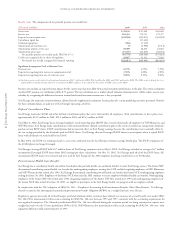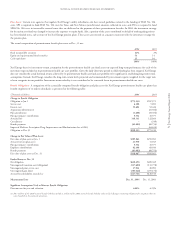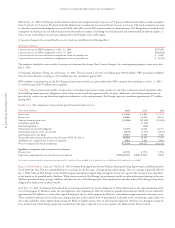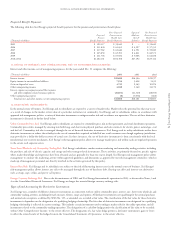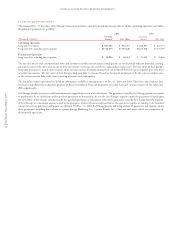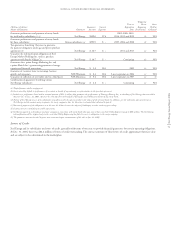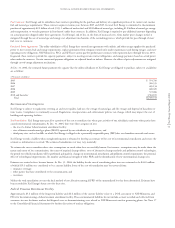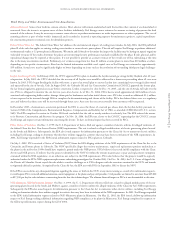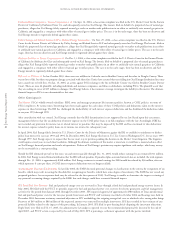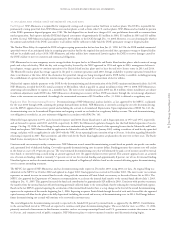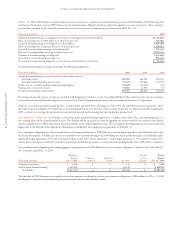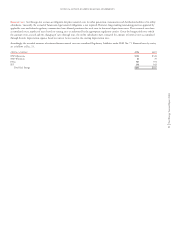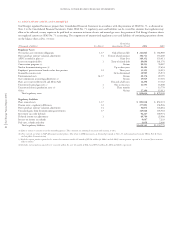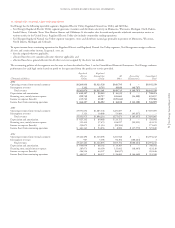Xcel Energy 2004 Annual Report Download - page 78
Download and view the complete annual report
Please find page 78 of the 2004 Xcel Energy annual report below. You can navigate through the pages in the report by either clicking on the pages listed below, or by using the keyword search tool below to find specific information within the annual report.
NOTES to CONSOLIDATED FINANCIAL STATEMENTS
Xcel Energy Annual Report 2004
76
Manufactured Gas Plant Sites
Levee Station Manufactured Gas Plant Site A portion of NSP-Minnesota’s High Bridge plant coal yard is located on the site of the former Levee Station
MGP site. The Levee Station was a coke-oven gas purification, storage and distribution facility. The Levee Station supplied manufactured gas to the city
of St. Paul from 1918 to the early 1950s. In the 1950s, the facility was demolished, and the High Bridge coal yard was extended onto the property. In
the 1990s, the site was investigated and partially remediated at a cost of approximately $2.9 million. In 2006, NSP-Minnesota plans to commence
construction of the High Bridge Combined Cycle Generating Plant, as part of the MERP, on the site of the Levee Station. The construction of the
new plant will require the removal of buried structures and soil and groundwater remediation. Remediation activities will begin in 2005. The cost of
the additional remediation is estimated to be $5.8 million, which will be accounted for as a capital expenditure of the MERP project.
Ashland MGP Site NSP-Wisconsin was named a PRP for creosote and coal tar contamination at a site in Ashland, Wis. The Ashland site includes
property owned by NSP-Wisconsin, which was previously an MGP facility, and two other properties: an adjacent city lakeshore park area, on which
an unaffiliated third party previously operated a sawmill, and an area of Lake Superior’s Chequemegon Bay adjoining the park.
As an interim action, Xcel Energy proposed, and the Wisconsin Department of Natural Resources (WDNR) approved, a coal tar removal and groundwater
treatment system for one area of concern at the site for which NSP-Wisconsin has accepted responsibility. The groundwater treatment system began
operating in the fall of 2000. In 2002, NSP-Wisconsin installed additional monitoring wells in the deep aquifer under the former MGP site to better
characterize the extent and degree of contaminants in that aquifer while the coal tar removal system is operational. In 2002, a second interim response
action was also implemented. As approved by the WDNR, this interim response action involved the removal and capping of a seep area in a city park.
Surface soils in the area of the seep were contaminated with tar residues. The interim action also included the diversion and ongoing treatment of
groundwater that contributed to the formation of the seep.
On Sept. 5, 2002, the Ashland site was placed on the National Priorities List (NPL). The NPL is intended primarily to guide the U.S. Environmental
Protection Agency (EPA) in determining which sites require further investigation. On Nov. 14, 2003, the EPA and NSP-Wisconsin signed an administrative
order on consent requiring NSP-Wisconsin to complete the remedial investigation and feasibility study for the site. On Dec. 7, 2004, the EPA approved
NSP-Wisconsin’s proposed work plan with minor contingencies to complete the remedial investigation and feasibility study. On Feb. 1, 2005, NSP-
Wisconsin submitted its revised work plan to the EPA addressing all of the contingencies raised with the previous proposal. The final approval results in
specific delineation of the investigative fieldwork and scientific assessments that must be performed. The estimated cost of carrying out the work plan
is $1.3 million in 2005. Resolution of Ashland remediation issues is not currently expected until 2007 or 2008. NSP-Wisconsin continues to work
with the WDNR to access state and federal funds to apply to the ultimate remediation cost of the entire site.
The WDNR and NSP-Wisconsin have each developed several estimates of the ultimate cost to remediate the Ashland site. The estimates vary significantly,
between $4 million and $93 million, because different methods of remediation and different results are assumed in each. The EPA and WDNR have
not yet selected the method of remediation to use at the site. Until the EPA and the WDNR select a remediation strategy for the entire site and
determine NSP-Wisconsin’s level of responsibility, the ultimate cost of remediating the Ashland site is not determinable. On July 2, 2004, the WDNR
sent NSP-Wisconsin an invoice for recovery of past costs incurred at the Ashland site between 1994 and March 2003 in the amount of $1.4 million.
On Oct. 19, 2004, the WDNR, represented by the Wisconsin Department of Justice, filed a lawsuit in Wisconsin state court for reimbursement of
the past costs. This lawsuit has been stayed until further action by either party. NSP-Wisconsin is reviewing the invoice to determine whether all costs
charged are appropriate. All appropriate insurance carriers have been notified of the WDNR’s invoice and the lawsuit and will be invited to participate
in any future efforts to address the WDNR’s actions. All costs paid are expected to be recoverable in rates.
NSP-Wisconsin has recorded a liability of $17.3 million for its estimate of its share of the cost of remediating the Ashland site, using information available
to date and reasonably effective remedial methods. NSP-Wisconsin has deferred, as a regulatory asset, the remediation costs accrued for the Ashland site
based on an expectation that the Public Service Commission of Wisconsin (PSCW) will continue to allow NSP-Wisconsin to recover payments for
environmental remediation from its customers. The PSCW has consistently authorized recovery in NSP-Wisconsin rates of all remediation costs incurred
at the Ashland site, and has authorized recovery of similar remediation costs for other Wisconsin utilities. External MGP remediation costs are subject
to deferral in the Wisconsin retail jurisdiction and are reviewed as part of the Wisconsin biennial retail rate case process for prudence. Once approved
by the PSCW, deferred MGP remediation costs, less carrying costs, are historically amortized over four or six years. In addition, the Wisconsin Supreme
Court rendered a ruling that reopens the possibility that NSP-Wisconsin may be able to recover a portion of the remediation costs from its insurance carriers.
Fort Collins MGP Site Prior to 1926, Poudre Valley Gas Co., a predecessor of PSCo, operated an MGP in Fort Collins, Colo., not far from the Cache
la Poudre River. In 1926, after acquiring the Poudre Valley Gas Co., PSCo shut down the MGP site and has sold most of the property. Recently, an oily
substance similar to MGP byproducts was discovered in the Cache la Poudre River. In early 2004, PSCo completed implementation of a work plan
to further investigate the sources of contamination of the river at a cost of approximately $1.4 million. The work resulted in removal of contaminated
sediments and delineation of the extent of the contamination.
On Nov. 10, 2004, PSCo entered into an agreement with the EPA, the city of Fort Collins and Schrader Oil Co., under which PSCo will perform
remediation and monitoring work at an estimated cost of $8.8 million. Work is currently under way, with completion of construction anticipated in
June 2005 followed by ongoing operation and maintenance.
To date, PSCo has spent approximately $3.4 million on the project, including settlement costs negotiated with the city of Fort Collins in 1998 and
costs incurred by the EPA. The EPA is also expected to seek recovery of its ongoing oversight costs from PSCo. PSCo has deferred the costs recorded
to date as a regulatory asset and believes that they will be recovered through future rates. Any costs that are not recoverable from customers will be expensed.


